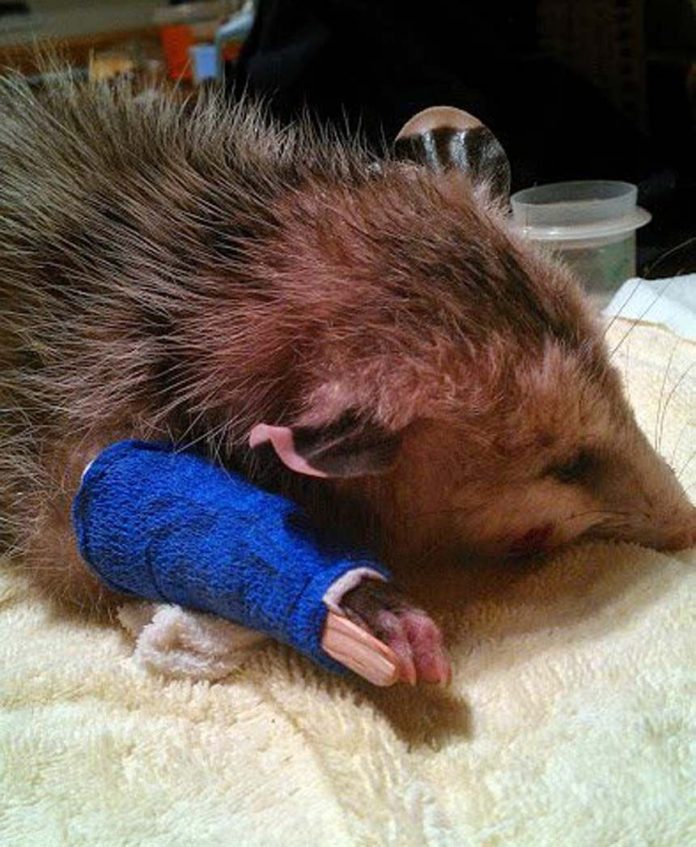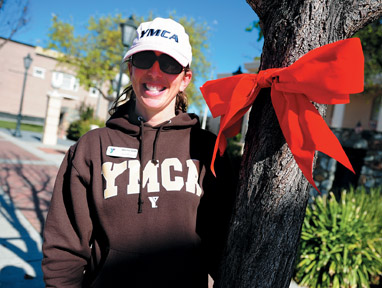To paraphrase Hamlet, the young opossum literally suffered the slings and arrows of outrageous (mis)fortune. It was walking along the top of a fence just minding its own business, perhaps looking for an evening meal of fallen fruit or crunchy snails, when a person deliberately shot it down with an arrow. A neighbor saw the poor creature desperately struggling and notified the Wildlife Education and Rehabilitation Center. Staff at WERC found the arrow had pierced the top of the front leg and through the chest, narrowly missing vital organs, but leaving him extremely weak and causing severe nerve damage in the leg. X-rays showed the humerus bone was shattered. It was with very sad hearts that this little opossum was euthanized.
A second young female opossum came to WERC after having been attacked by a dog. The tussle caused dire injury to the opossum’s left eye, permanently blinding it. Though the injury quickly healed without infection, it was determined that the animal’s chances of survival in the wild would be negligible. Though opossums rely heavily on their outstanding sense of smell, they do need adequate vision to help them avoid predators. But her misfortune has turned to fortune, because “Poppy O’Possum” is very sweet-tempered and otherwise healthy, and will be given a second chance for a happy life as an educational animal at a wildlife facility in Southern California.
The misfortunes of these two opossum are a loss to our ecosystem. Though often vilified as vermin, i.e. rats, misunderstood opossums are truly remarkable animals that survive on an omnivorous diet of fruits and berries, slugs, insects such as roaches and beetles, frogs, snakes (they are resistant to venom), small rodents and carrion. You could call them night-time sanitation engineers. In other words, they are a real benefit to us—a non-toxic method of environmental clean-up at no cost to the taxpayers.
Good news: Our wildlife community will soon be getting a new member of the pest control posse—a third young opossum “kidnapped” in August by another dog. Fortunately, it wasn’t injured badly and just had a few minor abrasions. Still, it was underweight, very weak and required close observation and special feeding. Its most unusual feature was the lack of the silvery guard hairs that cover the thicker undercoat. These guard hairs serve as a “rain coat,” helping keep the opossum dry during rainy season and while swimming (they are excellent swimmers). Fortunately, the opossum’s condition turned out not to be permanent and he has grown a beautiful fur coat that will protect him when he is released this week to a natural habitat.
Virginia opossums are North America’s only marsupial (animals with pouches to carry their babies). They are solitary critters, very rarely aggressive, do not dig up lawns and will not attack your pets if left alone. If hissing and baring their 50 teeth doesn’t scare away a predator (dogs, coyotes, foxes, raccoons, bobcats, eagles, hawks, owls and humans) they will “play sick” by drooling and pooping; if that doesn’t work, they will “play dead”—an involuntary, coma-like state lasting from a few minutes to a few hours. Since the opossum does not stay in one location more than a few days, if you don’t want them wandering around your yard, remove food sources such as fruit on the ground and pet food, and they will soon move on to another location. Or let them be and just enjoy this little friend of your garden and nature.
68.4
F
Hollister
April 17, 2024









